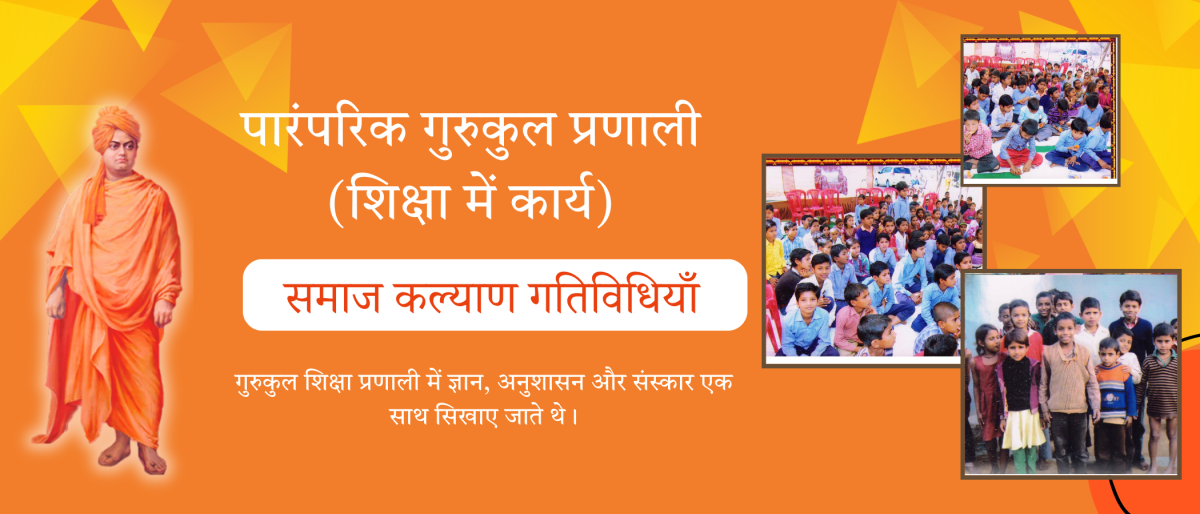Swami Vivekananda’s approach to education was deeply influenced by the traditional Gurukul system of learning, but he adapted it to suit the needs of modern society. The Gurukul system, in ancient India, was an informal and holistic form of education, where students (or “shishyas”) lived and learned under the guidance of a guru (teacher) in a natural, often secluded setting. This system emphasized close teacher-student relationships, moral development, and learning through life experiences.
In the context of Swami Vivekananda’s educational philosophy and the goals of a Yug Purush (person of the age) society, the Gurukul method would be adapted to meet contemporary needs, blending ancient wisdom with modern educational practices. Let’s explore how this could work in a Swami Vivekananda Educational and Social Welfare Society:
Key Elements of the Gurukul System in the Context of Swami Vivekananda’s Vision:
1. Holistic Education:
- Traditional Gurukul: In the traditional Gurukul system, education wasn’t just academic; it involved the development of the mind, body, and spirit. Students learned various subjects, including philosophy, literature, the arts, sciences, and physical training (like yoga and martial arts).
- Swami Vivekananda’s Approach: Vivekananda advocated for a holistic education system that would nurture not just intellectual abilities but also moral character, physical strength, and spiritual awakening. His focus was on making individuals self-reliant and socially responsible
- In the Yug Purush society, the Gurukul method would involve a well-rounded curriculum designed to develop every aspect of a student’s personality—academic knowledge, physical fitness, mental clarity, and spiritual growth.
2. Guru-Shishya Relationship:
- Traditional Gurukul: The student-teacher relationship in the Gurukul was personal and nurturing. The guru (teacher) acted as both an educator and a spiritual guide, closely mentoring students and guiding them in every aspect of life.
- Swami Vivekananda’s View: Vivekananda emphasized the importance of personal mentorship in education, where the teacher is not just an instructor but also a guide, inspiring students to develop their potential.
- In the Swami Vivekananda Educational Society, the Gurukul method would encourage teachers to take a personal interest in each student’s development, not just focusing on academic success but also their moral and spiritual growth. Teachers would embody the values they wish to instill in their students.
3. Learning by Experience:
- Traditional Gurukul: Students in the Gurukul system learned by observing, participating, and engaging with the environment around them. Learning was not just confined to books; students lived alongside their teachers, absorbing life lessons, moral values, and practical knowledge.
- Vivekananda’s Philosophy: Vivekananda believed that education should be experiential—learning through action and engagement with the real world. He often advocated for learning that connected theory with practice, so students would be prepared to handle life’s challenges with wisdom.
- The Yug Purush society would prioritize experiential learning, where students engage in practical activities like social service, environmental work, and leadership projects. They would also be taught real-world skills like entrepreneurship, healthcare, and communication, in addition to academic subjects.
4. Spiritual and Moral Education:
- Traditional Gurukul: In the ancient Gurukul system, moral and spiritual education was a core component. Students were taught the values of truth, righteousness, and duty. They learned the importance of ethical living and the role of spirituality in achieving a balanced life.
- Swami Vivekananda’s Ideals: Vivekananda strongly believed in the spiritual dimension of education, asserting that a person who is educated should also be morally strong and connected to higher ideals. He advocated for education that nourishes not only the intellect but also the soul.
- In the Yug Purush society, the Gurukul method would involve spiritual and moral teachings based on Vivekananda’s principles. Students would learn about self-discipline, ethical conduct, empathy, and their responsibility toward humanity. Vivekananda’s teachings of self-realization and service to humanity would form an integral part of their education.
5. Community and Collective Learning:
- Traditional Gurukul: The Gurukul was not just a place for individual learning but also a community-based system where students worked together, learned from one another, and shared knowledge and experiences.
- Vivekananda’s Social Welfare Vision: Swami Vivekananda believed that education should uplift the community as a whole. His idea was not just to create individual achievers but also individuals who could contribute to the greater good of society.
- The Gurukul method in the Yug Purush society would therefore emphasize community learning. Students would be encouraged to work in groups, contribute to social welfare initiatives, and collaborate on projects that serve the community. This would help foster a sense of social responsibility and collective well-being.
6. Physical and Mental Well-being:
- Traditional Gurukul: In the Gurukul system, physical fitness was also a key aspect of education. Students practiced physical activities like yoga, martial arts, and outdoor activities, which strengthened both the body and mind.
- In the Swami Vivekananda Educational and Social Welfare Society, the Gurukul method would include regular yoga practice, sports, and other physical activities that promote health and well-being. This would help students build strength, discipline, and resilience.
- Vivekananda’s Focus on Physical Strength: Swami Vivekananda placed great importance on physical strength as a means of achieving mental clarity and self-confidence. He encouraged the youth to be strong and healthy, as physical health is integral to mental and spiritual growth.
7. Moral and Spiritual Empowerment for All:
- Traditional Gurukul: Education in the Gurukul was generally available to all, regardless of caste, but often limited by social norms of the time.
- Vivekananda’s Inclusive Vision: Vivekananda was a fierce advocate for the upliftment of marginalized communities—especially women and lower-caste individuals. He strongly believed that education for all was essential for societal progress.
- The Gurukul method within the Swami Vivekananda Educational and Social Welfare Society would ensure that education is inclusive. Special efforts would be made to ensure that girls, children from low-income families, and people from marginalized communities have access to education that empowers them spiritually, intellectually, and socially.

